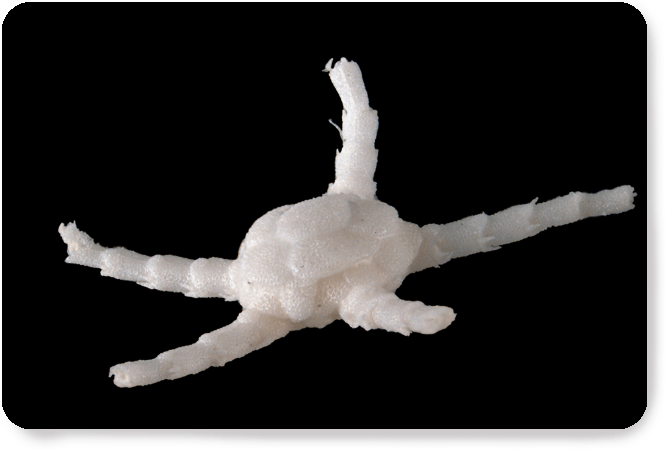
Home -> Species index -> Species description
 More images | Distribution map
More images | Distribution map | F 84188. Family - Ophiuridae. |
Description The disc is tumid, 3 mm diameter. The radial shields are round, contiguous over much of their length; 0.9–1.1 times long as wide, and length 0.1 times d.d. The dorsal surface is covered by plates, no spines/granules, with a visible diameter of 0.6–0.9 mm, overlapping; primary plates not visible. The ventral interradial surface is plated. The oral shields are exposed, fan shaped, wider than long. The adoral shields are exposed, extending to lateral edge of oral shield or dsital to lateral edge of oral shield, separated radially, meeting interradially. Bursal slits absent. The jaw is as wide as long or wider than long, with one, pointed or tapering apical papilla, as wide as long. Oral papillae absent. The oral tentacle pore is located inside the jaw, with distal oral papilla none. The specimen has five arms, unbranched, moniliform or basally constricted (constricted basally and distally, swollen in middle), 1–2 times d.d. Dorsal arm plates, separated, without spines/granules; diamond, and 0.6–0.7 times long as wide. The second ventral arm plates are separated from the third plate, fan-shaped, notched or concave laterally, and 0.8–1.2 times long as wide. Ventral arm plates of the first free segments separated, fan-shaped, notched or concave laterally, and 0.5–1 times long as wide. Tentacle pores along the arm, with no scales. There are 0–1 arm spines on the first ventral segment, 1 on the first free segments. The spines are adpressed to arm or erect, extending laterally, subequal, and 0.25–0.75 times as long as one arm segment, pointed, cylindrical. Glassy transparent shaft.
Description exported from Delta key and to be finalised when DNA sampling completed. Note species description and image characters may vary slightly in animals of different size within the same species. Cite this publication as: "T O'Hara
(2010). ‘Ophiuroids from deep sea southern Australia. Museum Victoria. Version:
1.0 http://www.museumvictoria.com.au/stars" MUSEUMVICTORIA |